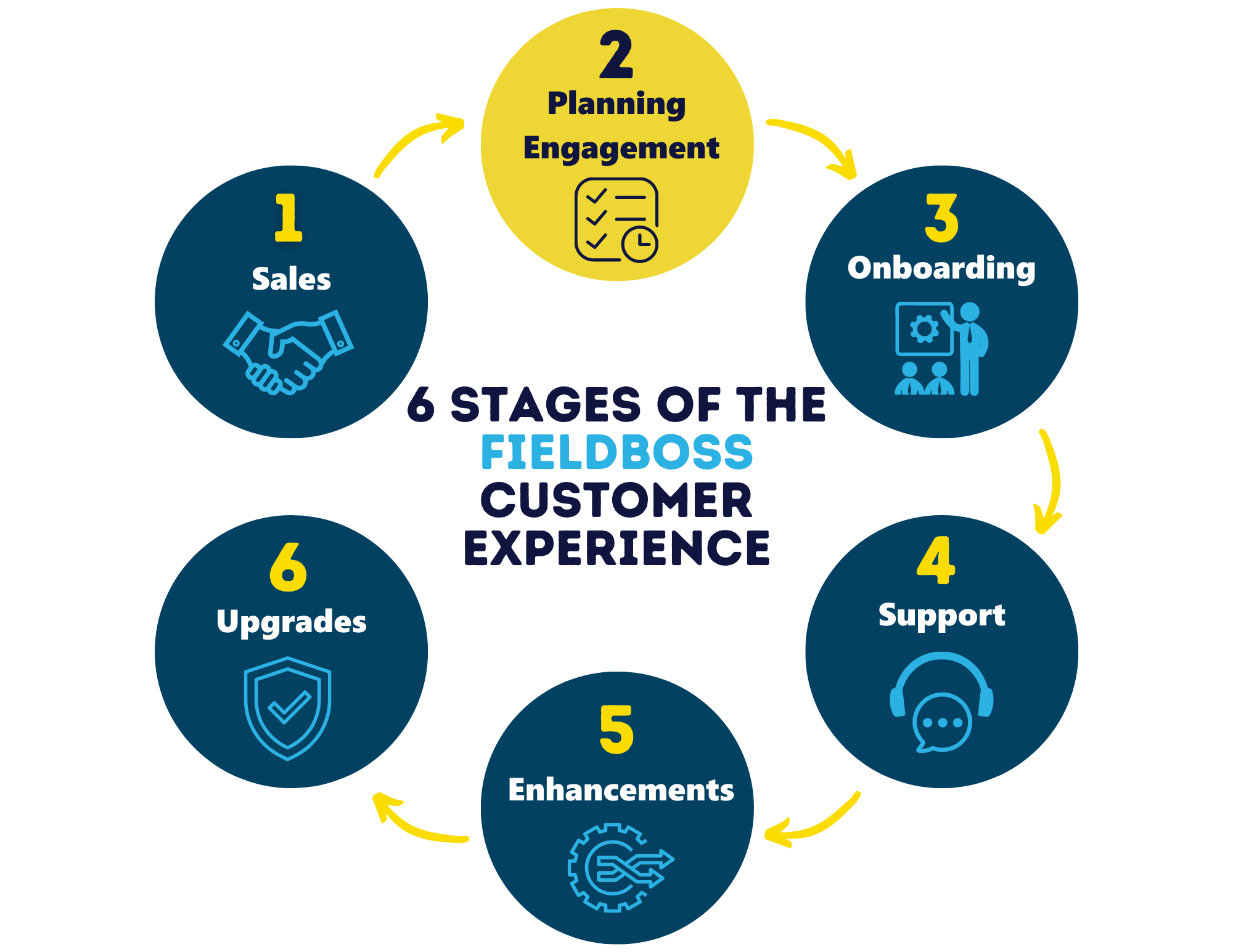FIELDBOSS is an enterprise level solution designed to allow small and medium-sized field service businesses to compete with their biggest competitors. At FIELDBOSS, we know not every company is equipped with experienced software implementation staff or have the time from ownership to commit to all the work required to evaluate this decision.
The planning process is used to bridge the gap between our customers, our staff and our award-winning software solution. If you want something done right the first time, you need to spend the time planning what you want the final product to look like!

What is a Planning Engagement?
The Basics – A planning engagement is a series of meetings with experienced FIELDBOSS Consultants and Project Managers to identify what makes your business unique, what makes it like others in your industry, what you need from a software solution and the first step to creating a long-term relationship between you and FIELDBOSS.
Think of it like a site survey – requirements gathering and project plan all rolled into 1!
Timeline – Planning engagements typically take between 3-6 weeks depending on client availability and solution complexity.
What is Covered in a Planning Engagement? – During the planning engagement process, we review details about your business, your staff and all the key modules in FIELDBOSS. The topics and business processes we cover include, but are not limited to:
- Business Overview
- Existing Software Systems
- Data Migration Plan
- External and Internal Reporting Requirements
- Sales Management
- Service Management
- Maintenance Contracts
- Projects
- Mobile
- Time Management
- Financial and Cash Management
- Purchasing, Inventory and Payables
- Invoicing and Receivables
Why Do We Do a Planning Engagement?
Industry Trends – According to studies, nearly 50% of all operational software implementations are not successful. There are many reasons for this, but the most common are:
- A lack of planning prior to project commencement
- Inexperience in software implementations by the customer, or the software provider resources
- The software vendor trying to force customers into an existing software ‘box’
- Lack of involvement by the customer and their staff
At FIELDBOSS, our customers claim a success rate of over 95% during our project close meetings. They often attribute the planning, our experienced implementation team, and the software capabilities as the reasons for this.
The Benefits to Our Customers – The planning engagement is all about risk mitigation. Owners understand that bringing in a new software can be a risky decision. Completing a planning engagement ensures a more accurate solution expectation, budget, and business expectation before committing.
At FIELDBOSS, we empower our customers by taking the time to help you and your staff get the most out of the solution and allow you to be decision makers in the process long before committing to implementing the software.
The Benefits to our Team – By performing a planning engagement, our customers start the onboarding process with a strong level of FIELDBOSS knowledge and an understanding of how the system works. Our customers understand their role and become partners in the software implementation with our team, not just cattle led through a pre-defined checklist.
We use senior implementation team members to onboard our new customers. With a significant account of the work agreed upon in the planning, it allows those staff to find, determine and perform value added tasks for our customers instead of just checking off boxes.
What Do you Receive at the End of a Planning Engagement?
At the end of every planning engagement, we complete and provide a fully detailed planning report that summarizes the scope of work for your project. The goal of this report is to provide our customers with a detailed understanding of the onboarding process, post onboarding experience, and their role and time commitment to the project.
The Planning Report includes the following:
- Value Propositions – Details based on your system requirements and existing state as a business on what the biggest operational and strategic benefits will be by moving to FIELDBOSS.
- Trade Off’s – The honest feedback of what deficiencies you can expect to experience when you undergo change management from your existing processes, so you can commit with eyes wide open.
- Scope of Work – A breakdown of every task our team will be responsible for, and the hours budgeted for that time. This allows us to allocate time and perform project control with full transparency to our customers.
- Not in Scope – What has been discussed that both parties have agreed will not be part of the project. Discussed items may be in a future phase or implemented once the client is more comfortable with the software.
- Customer Specific Development – Fully detailed description of every unique item the customer requested and the design for how our local team of experts will build what is required.
- Project Risks – A tool for us to identify where your onboarding will need more project control as well as the level of risk the business process changes may have on your staff.
- Project Plan – Timeline of the FIELDBOSS onboarding for both our team and yours. A list of customer deliverables and when they will be required so you can resource plan on your team to make the transition as smooth as possible.
- Licensing Details – A breakdown of the licenses involved from FIELDBOSS, Microsoft and our partners to provide you with full cost transparency.
Without this level of information being provided to you, you cannot be certain of the software or the company you are working with.
If you want to learn more about FIELDBOSS, our planning engagement process or the other stages in our customer lifecycle, please contact us or schedule a personalized demo.